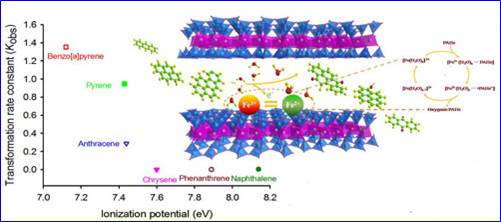Transformation of Polycyclic Aromatic Hydrocarbons (PAHs) on Fe(III)-modified Clay Minerals
Editor: | Sep 30,2014
Clay-driven abiotic transformation of organic contaminants (such as PAHs) is considered as a crucial factor affecting their retention in soil environment. Metal ions such as Fe(III) ions can also induce electron-transfer between exchangeable cations and adsorbed aromatic molecules on clay surfaces.
Prof. WANG Chuanyi’s group at Xinjiang Technical Institute of Physics & Chemistry, Chinese Academy of Sciences (XTIPC), demonstrate for the first time the transformation of several PAHs (such as naphthalene, phenanthrene, benzo[a]pyrene and pyrene) on clay minerals with various surface physicochemical properties under environmentally relevant conditions.
Researchers revealed that PAHs transformation is critically influenced by their molecular structure and clay surface properties. The PAHs with up to four rings (such as benzo[a]pyrene and pyrene) that have low IP values are readily transformed on Fe(III) saturated clay minerals. The surface chemical properties, i.e., the hydration of cations, fraction of Fe(III), layer charge location, and type of ligands, strongly affect the interaction between PAHs and Fe(III), thus modulate the reactivity of surface Fe(III)-species on the clay minerals. The electron-transfer process leads to the reduction of Fe(III) to Fe(II) and formation of organic radical cations, which are more stable in clay interlayers.
This study provides the first direct evidence for clay-catalyzed transformation of PAHs supporting the plausibility of their in situ degradation in soils, and demonstrates that abiotic reactions with surface-bound Fe(III) may affect or even dominate the long-term behavior of PAHs in soils.
The obtained results could be of significance in assessing the fate of various PAHs and the reactivity of surface-bound Fe(III) present on different clay mineral surfaces.
This work was supported by the National Natural Science Foundation of China, the CAS “Cross-Cooperation Program” for Creative Research Teams, “Western Action Plan” of the CAS, etc.

Catalytic oxidation processes of PAHs on Fe3+-modified smectite and effect of their molecular structure on their transformation activity. (Image by XTIPC)
附件下载:
 (86) 991-3838931
(86) 991-3838931 lhskj@ms.xjb.ac.cn
lhskj@ms.xjb.ac.cn (86)991-3838957
(86)991-3838957 40-1 Beijing Road
Urumqi, XinjiangChina
40-1 Beijing Road
Urumqi, XinjiangChina